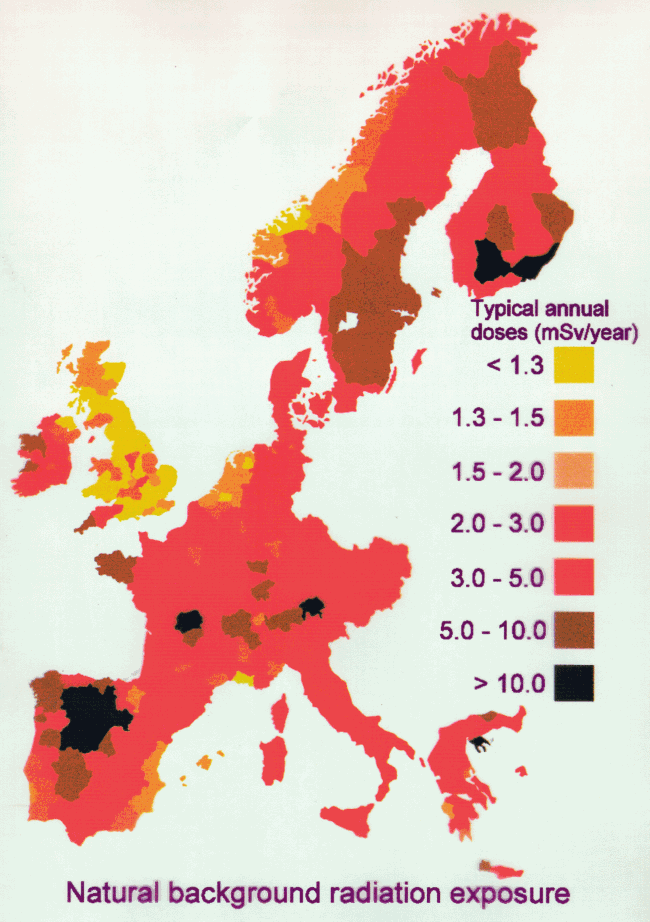Actually nowadays CT scans and mammograms account for the bulk of our radiation exposure. See article.
Doctors and physicians are overusing them and adding a huge radiation burden to our population. I came back to this topic because I had a spine xray recently, stupidly thinking that the dosage was the same as a chest xray. I even asked the chiropractor the milliseivert dosage and he just said "trust me it's low." I went online and found out a spine xray is about the same dosage as a CT scan! I've been taking resveratrol like mad now.
This kind of stuff annoys me like crazy because it's totally unnecessary and the use of xray in high doses is completely antithetical to what doctors are supposed to stand for. How in the world a doctor in the 21st century could condone using an old fashioned technology known to seed cancers is beyond me. On top of that most of the lab techs assigned to the CT and xray machines often aren't properly trained, make wild assumptions about dosage or are so lazy they just toss people into the beam and turn the dial. There was one case I read where a lab tech left a three year old kid in a CT machine for two hours!! Can you imagine being that kid's father or mother, knowing that anytime in the future your kid could display cancer? And the doctors always say that the benefits of xray outweigh the risks... so you are to tell me that a person with a broken rib should be glad that they were given a vastly more severe risk to their well being 10 years down the line to preserve a small bone?! Not all cancers kill mind you, they often just eat away at a person and their wallet and leave them a husk! Is this the false equivalence we patients should have to swallow? What's up doc?
Ask yourself this, would you let an indifferent, gum-chewing, college age lab tech wield a high powered laser over your body? Or even a factory line chiropractor who zaps anyone who walks in the door? That's essentially the attitude with xrays, except you can't see or feel the beam. These machines are too dangerous not to have extremely low Federally mandated limits. Way too much trust has been levied to our medical industry to allow this arcane tech to flourish. I mean I've seen live video xray machines being used in chiropractic offices, it sure looks cool to see a skeleton move but the patient must've been bombarded with a lifetime of rays! Insanity! That chiropractor should be tried for malpractice. Maybe even murder.
There's actually few if any real reasons to use radiation scans since we have perfectly fine ultrasound and MRI technology. The public doesn't really know the risks of xrays and the doctors base their confidence in the machines based on foolishly derived methodologies. So that's why you have naive patients walking into the firing zone of xray blasts courtesy of Dr. Blankstare. If you look into the justification for xrays you'll find that the studies compare xray dose limits with annual exposure limits. For instance an energy state fired in one second that would be equivalent to a years worth of radiation is considered a relatively low dose... but that's a horrible equivalence. That's like saying being hit with 50 rocks at the same time is equivalent to being hit with one rock over 50 days. What do you think your body could handle better?
These annual exposure limits were determined by the population of WWII survivors around Nagasaki, they estimated that one mile away from the blast the survivors received a dosage of about 3-5 msv/hr and their incidence of cancer only went marginally up. So they figured that your average human could tolerate a similar amount. But remember this is per hour, not per second... and the kicker is that nowadays some people are getting like 6-10 msv per CT scan! You could receive less radiation being 1 mile away from an atomic explosion than you would if you got three spinal xray sets done! Mental cases must be running the FDA! It is totally inconceivable that radioactive pollution of this sort could be allowed in a 1st world society! Some greedy xray maker must've pushed their agenda into the medical textbooks because I cannot for the life of me understand how doctors could condone such a silent monster like xray irradiation? When did doctors agree to gamble with cancer so flippantly? If a pharmaceutical drug were to hit the market with the same effects of a high energy xray blast you would have lawsuits galore!
We know that the human body is designed to handle a little radiation over time, but the justifications the medical community are trying to pitch are outrageous and when you look at it carefully they are based on spurious, false equivalencies. It's as if every doctor wants to justify that new $500K scanner he/she bought as a way to indemnify them from medical lawsuits. Are these new doctors psychopaths? I believe they've grossly oversimplified the risks of xray energy diagnostics particularly for levels anywhere above .05 msv. If they were to ban all diagnostics above that level this would remove all spinal, CT scan and mammograms from the American xray diet. They should all be replaced with ultrasound or MRI.
Consider this: Astronauts in space are given space suits to protect them from less xray radiation in a month than what the typical kid with a bump on their head receives in a matter of seconds!! Sometimes the scan, like the one I had, was equivalent to 200 chest xrays! When did the medical community suddenly become brainless, zombified and backward? Do they have fingers in their ears or something??
Sorry for the rant.
http://well.blogs.ny...verlooked/?_r=0
Edited by solbanger, 27 September 2015 - 07:02 AM.






















































